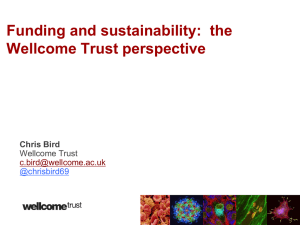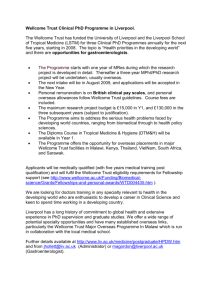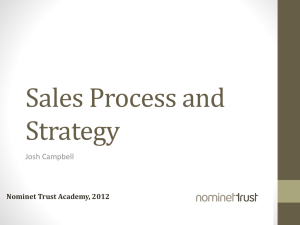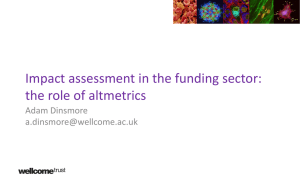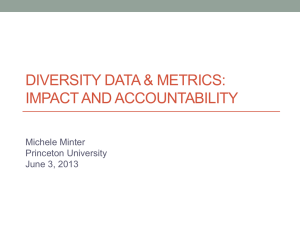Slides - OASPA
advertisement
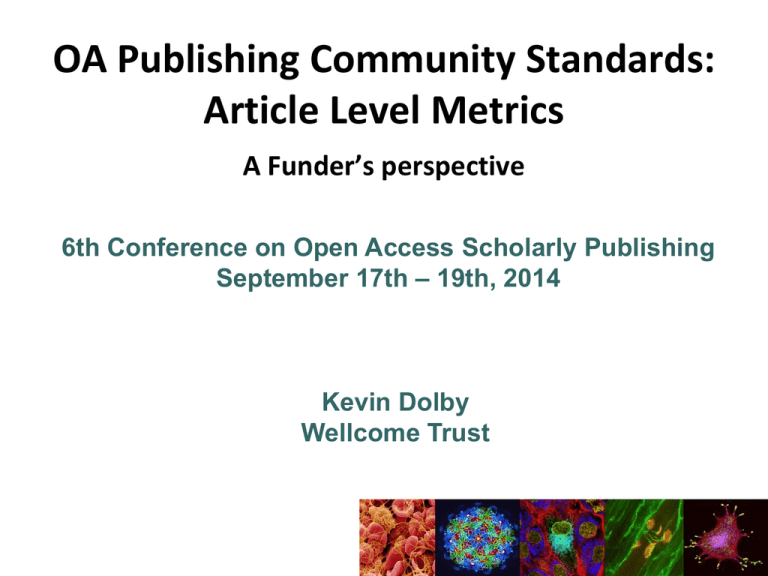
OA Publishing Community Standards: Article Level Metrics A Funder’s perspective 6th Conference on Open Access Scholarly Publishing September 17th – 19th, 2014 Kevin Dolby Wellcome Trust OutlineO The Wellcome Trust How we use Article Level Metrics Why they are important to us Current sources of data (and the problems with them) Initiatives and collaborations changing the landscape The Wellcome Trust Set up in 1936 under the will of Sir Henry Wellcome. Our vision is to achieve extraordinary improvements in human and animal health. Our mission is to support the brightest minds in biomedical research and the medical humanities. We spend approximately £650 million on research per year. Current grant portfolio Monitoring progress: WT’s key indicators Outcomes Key indicators of progress Discoveries 1. 2. significant advances in the generation of new knowledge contribute to discoveries with tangible impacts on health Applications 3. 4. contribute to the development of enabling technologies, products and devices uptake of research into policy and practice Engagement 5. 6. enhanced level of informed debate in biomedicine significant engagement of key audiences & increased reach Research leaders 7. 8. develop a cadre of research leaders evidence of significant career progression among those we support Research environment 9. 10. key contributions to the creation, development and maintenance of major research resources contributions to the growth of centres of excellence 11. 12. significant impact on science funding & policy developments significant impact on global research priorities and processes Influence Article level metrics vs. Journal level metrics o Cited 2904 times; o Normalised Citation Impact = 327; o Acta Crystal D JIF = 7.232 Alternative metrics – beyond citations Engagement and Influence MEP Centre for Bioethics MEP Professor of EBM Journal editor Health journalist NGO Health, Population & Nutrition @ The World Bank Monitoring progress: WT’s key indicators Outcomes Key indicators of progress Discoveries 1. 2. significant advances in the generation of new knowledge contribute to discoveries with tangible impacts on health Applications 3. 4. contribute to the development of enabling technologies, products and devices uptake of research into policy and practice Engagement 5. 6. enhanced level of informed debate in biomedicine significant engagement of key audiences & increased reach Research leaders 7. 8. develop a cadre of research leaders evidence of significant career progression among those we support Research environment 9. 10. key contributions to the creation, development and maintenance of major research resources contributions to the growth of centres of excellence 11. 12. significant impact on science funding & policy developments significant impact on global research priorities and processes Influence Sources of data We need article-level data which is consistent in its source and meaning in order to enable sensible comparisons between outputs of different schemes Differences between publisher-provided data mean that, primarily, we use third-party data providers: Thomson Reuters Web of Knowledge Altmetric Citation data Differences in citation data Differences in citation data Source Scopus Web of Science Google Scholar CrossRef PMC EuropePMC Number of citations 76 64 103 56 44 66 For a sample of 358 Wellcome-associated papers, on average: o WoS had 10 cites per paper o Scopus 12 cites per paper o Google Scholar 18 cites per paper NISO Altmetrics project Aim to “undertake a two-phase initiative to explore, identify, and advance standards and/or best practices related to a new suite of potential metrics in the community” First meeting in October 2013 The first phase identified areas for potential standardization; a consultation period has sought to prioritise these areas; phase two will advance and develop these standards. Final report due in November 2015 Shared sources – the ALM app CrossRef DOI Event Tracker (DET) Pilot Pilot group of publishers and potential users of this data Aim is to test the feasibility of developing and running an industry-scale infrastructure to track, store and propagate DOI-related “events”. These “events” may be come from a wide range of sources including: scholarly publications professional or grey literature scholarly tools mainstream media social media. CrossRef DOI Event Tracker (DET) Pilot Looking to establish that it’s possible (and important) to separate out the infrastructure needed for tracking common information about the events from the value– added services (e.g. analysis and visualization) So there will be the basic data available for all, with potential “premium” services on top. More to follow… Key points If ALM data is to be useful we have to understand where it comes from and what it means Consistency would be good, transparency even more important Availability is vital thank you k.dolby@wellcome.ac.uk 6th Conference on Open Access Scholarly Publishing September 17th – 19th, 2014





